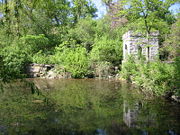
Camp Coldwater
Encyclopedia

Spring (hydrosphere)
A spring—also known as a rising or resurgence—is a component of the hydrosphere. Specifically, it is any natural situation where water flows to the surface of the earth from underground...
that are important to Native Americans
Native Americans in the United States
Native Americans in the United States are the indigenous peoples in North America within the boundaries of the present-day continental United States, parts of Alaska, and the island state of Hawaii. They are composed of numerous, distinct tribes, states, and ethnic groups, many of which survive as...
, as well as an early Europe
Europe
Europe is, by convention, one of the world's seven continents. Comprising the westernmost peninsula of Eurasia, Europe is generally 'divided' from Asia to its east by the watershed divides of the Ural and Caucasus Mountains, the Ural River, the Caspian and Black Seas, and the waterways connecting...
an settlement in the state of Minnesota
Minnesota
Minnesota is a U.S. state located in the Midwestern United States. The twelfth largest state of the U.S., it is the twenty-first most populous, with 5.3 million residents. Minnesota was carved out of the eastern half of the Minnesota Territory and admitted to the Union as the thirty-second state...
, USA. Camp Coldwater is located adjacent to the Mississippi River
Mississippi River
The Mississippi River is the largest river system in North America. Flowing entirely in the United States, this river rises in western Minnesota and meanders slowly southwards for to the Mississippi River Delta at the Gulf of Mexico. With its many tributaries, the Mississippi's watershed drains...
in south Minneapolis
Minneapolis, Minnesota
Minneapolis , nicknamed "City of Lakes" and the "Mill City," is the county seat of Hennepin County, the largest city in the U.S. state of Minnesota, and the 48th largest in the United States...
, directly south of Minnehaha Park.
The camp was explored by early European settlers who were in the process of building Fort Snelling. On May 5, 1820, Lieutenant Colonel Henry Leavenworth
Henry Leavenworth
Henry Leavenworth was an American soldier active in the War of 1812 and early military expeditions against the Plains Indians...
moved his troops to the area because their former encampment, on the Minnesota River
Minnesota River
The Minnesota River is a tributary of the Mississippi River, approximately 332 miles long, in the U.S. state of Minnesota. It drains a watershed of nearly , in Minnesota and about in South Dakota and Iowa....
, was causing unhealthy conditions. He was succeeded by Colonel Josiah Snelling
Josiah Snelling
Colonel Josiah Snelling was the first commander of Fort Snelling, a fort located at the confluence of the Mississippi and Minnesota rivers in Minnesota. He was responsible for the initial design and construction of the fort, and he commanded it from 1820 through 1827. He had a reputation for...
in August of that year. The soldiers lived in tents and huts on the site during three summers while they built the permanent stone fort south of the location. The spring continued to supply water to the fort, first via water wagons and then via a stone water tower and underground pipes. Settlers who had left the Selkirk Colony settled near the location in 1821, but were forced to leave in 1840. They moved down the Mississippi River and settled in what eventually became Saint Paul, Minnesota
Saint Paul, Minnesota
Saint Paul is the capital and second-most populous city of the U.S. state of Minnesota. The city lies mostly on the east bank of the Mississippi River in the area surrounding its point of confluence with the Minnesota River, and adjoins Minneapolis, the state's largest city...
. The Coldwater area once housed blacksmith shops, stables, trading posts, a hotel, and a steamboat landing, but nearly all of those buildings were gone by the time of the American Civil War
American Civil War
The American Civil War was a civil war fought in the United States of America. In response to the election of Abraham Lincoln as President of the United States, 11 southern slave states declared their secession from the United States and formed the Confederate States of America ; the other 25...
.
The Minnesota Department of Transportation set a national precedent in 2003 by building an eight-layer synthetic liner under the nearby Highway 55/62 interchange, specifically to protect the underground water flows to the spring. The liner allows the new Hwy 62 roadbed to dip below the water table at the interchange while also allowing the water to flow beneath the road to the spring.
The Coldwater site is located on the United States Bureau of Mines
United States Bureau of Mines
For most of the 20th century, the U.S. Bureau of Mines was the primary United States Government agency conducting scientific research and disseminating information on the extraction, processing, use, and conservation of mineral resources.- Summary :...
property east of Minnesota State Highway 55
Minnesota State Highway 55
Minnesota State Highway 55 is a highway in west-central, central, and east-central Minnesota, which runs from the North Dakota state line near Tenney and continues east and southeast to its eastern terminus at its intersection with U.S...
. The property was transferred to the National Park Service
National Park Service
The National Park Service is the U.S. federal agency that manages all national parks, many national monuments, and other conservation and historical properties with various title designations...
in 2010, and made a unit of the Mississippi National River and Recreation Area
Mississippi National River and Recreation Area
The Mississippi National River and Recreation Area protects a and corridor along the Mississippi River from the cities of Dayton and Ramsey, Minnesota to just downstream of Hastings, Minnesota. This includes the stretch of Mississippi River which flows through Minneapolis and St. Paul, Minnesota...
.

